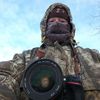Confused – aperture setting for landscape shots – f/11 or f/22 recommended?
Sep 16, 2019 20:56:46 #
TriX wrote:
It depends on the format, but in general, I try not to go past f11 based on my tests of my lenses on my FF body.
Trix, really appreciate the post. Your understanding and analysis of cameras and lens far surpass my feeble understanding of the triangle and how f stops impact the quality of pictures. BUT I assume that every photographer starts at some level of understanding and builds on it. See a diagram such yours gives me a better pictorial of what happens with the quality of the shot using different f stops.
I do appreciate your input.
Jose
Sep 16, 2019 22:13:06 #
Base_fiddle wrote:
Bleirer - Thanks for sending me the Advanced DoF C... (show quote)
The calculator is a phone app, so you don't need a connection. You might not want to have your eyes on your phone when you have something more interesting to look at, though. That Peterson book you read calls f8 the "who cares" setting, if I recall. It's enough to get fair depth of field, doesn't hurt with diffraction, and allows a faster shutter speed than f22 would. There are rules of thumb to approximate the hyperfocal distance, or you can use the app, but there is really only one plane of sharp focus and that is to focus on the subject. Depth of field near and far limits gives "acceptably sharp" focus but that is a compromise and not tack sharp.
Sep 16, 2019 22:43:52 #
bleirer wrote:
...There are rules of thumb to approximate the hyperfocal distance, or you can use the app, but there is really only one plane of sharp focus and that is to focus on the subject. Depth of field near and far limits gives "acceptably sharp" focus but that is a compromise and not tack sharp.
👍👍 Well said. There is an old “rule of thumb” about focusing 1/3 the way into the scene to approximate the hyperfocal distance, but if you plug in some values into the DOF calculator, you’ll see that it isn’t accurate. If you download the calculator to your phone and preset your camera and lens values, it only takes a couple of seconds to plug in the aperture and distance and read the hyperfocal distance. After you use it a bit, you’ll get a feel for that lens, distance and aperture and won’t need to use it all the time.
Sep 17, 2019 05:32:44 #
CHG_CANON wrote:
Rather than still more inconsistent feedback, why ... (show quote)
First intelligent response I have seen on this subject here in this post.
My sentiments as well.
Rather than stupid pontificating go do a test in real life with your real lenses.



Sep 17, 2019 05:38:06 #
F16 I use when I want the scene to be in focus more. The background. Mid and foreground. I use f8 to f11 on ther landscape scenes with no foreground interest. I go below f8 when scenes have low light such as the blue or golden hours.
Remember that over f11 shutter speeds can slow quite a bit and you may need a tripod to eliminate motion blur.
Depending on what you are intending to convey will determine what f stop to use also.
Remember that over f11 shutter speeds can slow quite a bit and you may need a tripod to eliminate motion blur.
Depending on what you are intending to convey will determine what f stop to use also.
Sep 17, 2019 05:42:14 #
CHG_CANON wrote:
Rather than still more inconsistent feedback, why ... (show quote)
Top stuff from CHG_CANON again, you can learn a lot from books and You tube, but the best lessons are those you teach yourself.
Sep 17, 2019 06:46:31 #
CHG_CANON wrote:
Rather than still more inconsistent feedback, why ... (show quote)
CHG_CANON has nailed it. No better advice can be found. Rather than depend on someone else's experiences with their equipment, you will know the optimum settings for your equipment.
Sep 17, 2019 07:02:41 #
Base_fiddle wrote:
I am going to the Antarctic and plan to take a num... (show quote)
My Understanding the best general aperture settings is f/8 or f/11. Correct me if I am wrong. I agree with taking test shots from f/8 thru f/22 and checking the images on a computer.
Sep 17, 2019 07:16:48 #
Base_fiddle wrote:
I am going to the Antarctic and plan to take a num... (show quote)
I would be guided by the level of accomplishment of those who profess to have the answer. Peterson is a leader in his field.
Sep 17, 2019 07:23:35 #
billnikon
Loc: Pennsylvania/Ohio/Florida/Maui/Oregon/Vermont
Base_fiddle wrote:
I am going to the Antarctic and plan to take a num... (show quote)
I use a Nikon 16-35 f4 for my landscapes. Typically your best images come from stopping down between 3 and 4 stops. So, on my f4 lens, it would be f11 or f16. I have personally found the IQ drops off the further you stop down. I generally stay away from anything over f16 with that lens. I actually prefer f11 as my sweet spot on that particular lens. And my sweet spot changes from one lens to another. For example, I have found my sweet spot on my Nikon 200-500 f5.6 to be f6.3. Photography sure is interesting.
Sep 17, 2019 07:35:00 #
Collhar wrote:
I would be guided by the level of accomplishment of those who profess to have the answer. Peterson is a leader in his field.
How does Bryan address the subject?
Sep 17, 2019 07:39:46 #
ggenova64 wrote:
How does Bryan address the subject?
"I’ve read Bryan Peterson’s "UNDERSTAINDING EXPOSURE" and saw that many of his landscape shots were taken with a f/22 aperture."
Sep 17, 2019 08:05:18 #
It really depends more today on high megapixel cameras being packed tighter and tighter on a sensor . The closer the spacing of the pixels the more diffraction affects you , the circle of confusion begins to cover more pixels . When the airy disc covers more than 2 pixels diffraction can accur at small f stops . They say on a nikon d 810 this can begin at f5.6 but is generally accepted f8 . And that sensor is 36 megapixels . So since I own a d810 I started there . I read many articles by renown landscape photographers and settled on what to try in testing that shooting at 14mm to 18mm on my 14mm- 24mm f2.8 nikkor that using a hyperlocal distance of 10 feet and f13 to f16 everything from 3 feet out was clean enough in focus for 24 x 60 prints if I output sharpened in post . I have been doing that now for years ..it depends on the quality of glass the sensor , the tripod , the first curtain shutter , the remote trigger and 14 bit raw and of coarse the right exposure from at least 3 bracketed images that I shoot at so I have all it takes to stack the deck for a sharp image also helps that this camera has 14.8 stops of light at base ISO 64. This is how I shoot landscapes and print for sale ...these are the results for Me that I am happy with using recommendations from others before me that say I can eliminate most effects in post of diffraction . I do highly suggest using ON1 genuine fractals resize as the choice in software for upsizing I have used it for over 8 years or more Or around when it first came out and Shutterbug ran tests with it , this is my experience it may be different for you..
Sep 17, 2019 08:16:44 #
Good morning. You can shoot nearly all landscape photographs at an aperture of f/8 using the hyperfocal distance technique. I've done so for years and obtained sharp pictures. I use the rule of thumb of focussing in the frame about 1/3 of the distance between the camera and infinity. This technique does require practice. I will go to an aperture of f/11 depending on conditions.
Note that I recommend setting the camera to Aperture Priority for f/8 while manually controlling ISO and Shutter Speed, with an emphasis on keeping the ISO low for the best image quality. I can get sharp pictures down to 1/10 of a second. The Camera Shake Reduction filter in Photoshop can minimize if not eliminate motion blur in the image.
Note as well that I shoot handheld despite the ballyhoo, mostly from shills, asserting the necessity of a tripod. Improved image stabilization paired with careful hand-holding technique together obviate a tripod. See this Ken Rockwell critique of the tripod: https://www.kenrockwell.com/tech/digital-killed-my-tripod.htm In summary, he writes: "Many people still cling to the mystique of the tripod, even though tripods went out with film cameras." He does qualify this sweeping statement.
Note that I recommend setting the camera to Aperture Priority for f/8 while manually controlling ISO and Shutter Speed, with an emphasis on keeping the ISO low for the best image quality. I can get sharp pictures down to 1/10 of a second. The Camera Shake Reduction filter in Photoshop can minimize if not eliminate motion blur in the image.
Note as well that I shoot handheld despite the ballyhoo, mostly from shills, asserting the necessity of a tripod. Improved image stabilization paired with careful hand-holding technique together obviate a tripod. See this Ken Rockwell critique of the tripod: https://www.kenrockwell.com/tech/digital-killed-my-tripod.htm In summary, he writes: "Many people still cling to the mystique of the tripod, even though tripods went out with film cameras." He does qualify this sweeping statement.
Base_fiddle wrote:
I am going to the Antarctic and plan to take a num... (show quote)
Sep 17, 2019 08:25:09 #
If you want to reply, then register here. Registration is free and your account is created instantly, so you can post right away.








